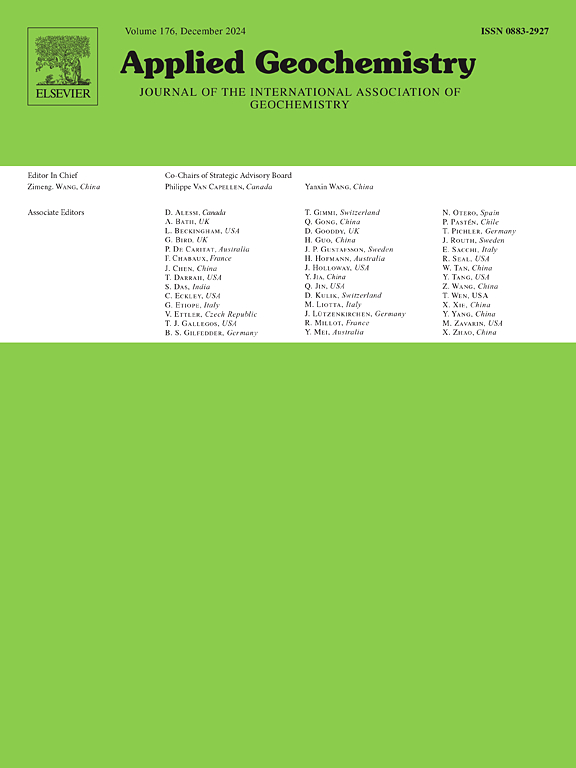Molecular markers of carbazole compounds in crude oils from NW China: Implications for organic facies and depositional paleoenvironment
IF 3.4
3区 地球科学
Q1 GEOCHEMISTRY & GEOPHYSICS
引用次数: 0
Abstract
The Tarim, Qaidam, and Ordos basins, located in Northwest China, are recognized as three significant oil and gas reservoirs, and a comprehensive geochemical analysis of the crude oils sourced from these basins has been conducted to elucidate the various factors, that influence the concentrations and distribution patterns of carbazole compounds. The average concentration of carbazole compounds in fresh lacustrine facies crude oil is significantly higher compared to those from salt lake facies and marine facies. Furthermore, salinity exerts a significant influence on the alkylation of methylcarbazole, whereas its effect on dimethylcarbazole alkylation is comparatively less pronounced. Under the premise of fully correcting the migration distance, the sedimentary environment (salinity, redox conditions) plays a dominant role in the distribution of carbazole compounds. Sedimentary facies and depositional environments also affect the total nitrogen concentrations and maturity-related parameters, such as the 1-MC/4-MC ratio. However, these factors minimal influence on migration indicators, such as the ratios of 3-MC/4-MC, 1,8-DMC/2,7-DMC, 1,3-DMC/2,7-DMC, and [a]/([a] + [c])-BC, which serve as reliable diagnostic tools for inferring the sedimentary environment. These findings indicate that carbazole compounds can serve as valuable tools for oil-source correlation studies.
中国西北地区原油中咔唑类化合物的分子标志:有机质相和沉积古环境意义
塔里木盆地、柴达木盆地和鄂尔多斯盆地被认为是中国西北地区三个重要的油气储层,通过对这三个盆地原油的地球化学分析,阐明了影响咔唑类化合物浓度和分布规律的各种因素。新鲜湖相原油中咔唑类化合物的平均浓度明显高于盐湖相和海相原油。盐度对甲基咔唑的烷基化有显著影响,而对二甲基咔唑的烷基化影响相对较小。在充分校正迁移距离的前提下,沉积环境(盐度、氧化还原条件)对咔唑类化合物的分布起主导作用。沉积相和沉积环境也会影响总氮浓度和成熟度相关参数,如1-MC/4-MC比值。3-MC/4-MC、1,8- dmc /2,7- dmc、1,3- dmc /2,7- dmc和[a]/([a] + [c])-BC等为推断沉积环境的可靠诊断工具,但这些因素对其影响较小。这些发现表明,咔唑类化合物可作为油源相关性研究的重要工具。
本文章由计算机程序翻译,如有差异,请以英文原文为准。
求助全文
约1分钟内获得全文
求助全文
来源期刊

Applied Geochemistry
地学-地球化学与地球物理
CiteScore
6.10
自引率
8.80%
发文量
272
审稿时长
65 days
期刊介绍:
Applied Geochemistry is an international journal devoted to publication of original research papers, rapid research communications and selected review papers in geochemistry and urban geochemistry which have some practical application to an aspect of human endeavour, such as the preservation of the environment, health, waste disposal and the search for resources. Papers on applications of inorganic, organic and isotope geochemistry and geochemical processes are therefore welcome provided they meet the main criterion. Spatial and temporal monitoring case studies are only of interest to our international readership if they present new ideas of broad application.
Topics covered include: (1) Environmental geochemistry (including natural and anthropogenic aspects, and protection and remediation strategies); (2) Hydrogeochemistry (surface and groundwater); (3) Medical (urban) geochemistry; (4) The search for energy resources (in particular unconventional oil and gas or emerging metal resources); (5) Energy exploitation (in particular geothermal energy and CCS); (6) Upgrading of energy and mineral resources where there is a direct geochemical application; and (7) Waste disposal, including nuclear waste disposal.
 求助内容:
求助内容: 应助结果提醒方式:
应助结果提醒方式:


